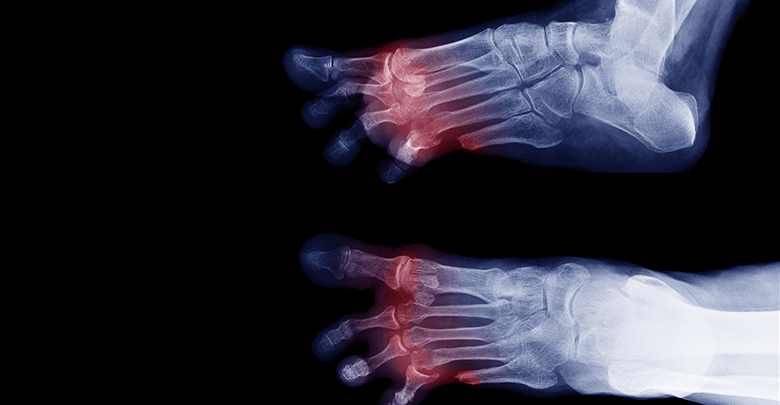Lower Extremity Amputations Are Most Common in Type 1 Patients
New Aetion study finds people with type 1 diabetes are 3.5 more likely to suffer amputation than people living with type 2

Among the many complications from diabetes, foot and leg amputations may be one of the most widely known to those outside of the diabetes community.
But, until very recently, the actual rates of amputation among people with type 1 versus type 2, was not well understood. Now, a new data study by Aetion is shedding some light on how often this severe complication effects each group. And the results for the type 1 community are more than just a little disheartening.
How Diabetes Leads to Amputation
There’s a reason foot amputations are one of the better-known diabetes complications. Every year in the US, about 73,000 lower extremity amputations (LEA) are performed on people with diabetes.
Across the globe, it is estimated that a person loses a limb to diabetes every 30 seconds.
Why is Amputation is so Common
Amputations are often the result of two other, less severe diabetes complications.
- Neuropathy, which affects about half of all people with diabetes, is a type of nerve damage that can cause tingling, pain, and numbness in the extremities.
- In more advanced cases, the ability to feel can be completely lost in the feet and hands.
- Peripheral artery disease (PAD), a slightly less common complication that occurs in about 30% of people with diabetes who are over the age of 50.
- It affects blood flow in the arteries.
- PAD occurs when vessels hardened by frequent high blood sugars become narrowed or blocked by fat deposits.
- Along with reduced circulation to the hands and feet, PAD also restricts the body’s white blood cells from effectively fighting infection in these areas.
It is the combination of neuropathy and PAD that sets the stage for amputation by reducing a person’s ability to feel an injury to the foot while also increasing the likelihood of severe infection. If left untreated, an infected injury or abscess can quickly turn gangrenous.
In cases of severe infection or gangrene, amputation is often the only way to assure the infection does not spread up the leg or to the rest of the body.
New Study Finds T1Ds at Higher Amputation Risk than T2Ds
While the rates of amputation among all people with diabetes have been well documented, how these rates differ between type 1 and type 2 diabetics has not been as clear.
But now, thanks to a new study published in Diabetes, Obesity, and Metabolism, we have a much better idea of how often this complication affects each group specifically.
The study, which used the Aetion Evidence Platform, a scientifically validated software capable of performing rapid analyses to generate real-world evidence at scale, analyzed the data of approximately 112.5 million unique insured beneficiaries to determine the rates of LEA among people with diabetes.
Type 1 people are about 3.5 times more likely to suffer amputation than their type 2 counterparts.
Of LEA cases identified in type 1 patients, only 30% were considered “major” amputations consisting of the entire foot or larger portions of the leg. The vast majority of amputations affected only the toes or smaller regions of the foot.
Overall, the study found that type 2 patients are about 20 times more likely than people without diabetes to suffer LEA, while type 1 patients are about 72 times more likely to suffer this complication.
Steps You Can Take to Lower Your Amputation Risk
As disheartening as the rates of LEA are for people with type 1 diabetes, it is important to keep in mind that there are no guarantees you will develop this complication. This is especially true if you take certain measures to keep yourself healthy and keep your diabetes in check.
Here are some simple steps you can take to reduce your amputation risk:
- Check your feet daily for injuries. Reduced sensation in the extremities means you may not notice a cut or foreign body right away, so it is important to physically look for problems frequently and consistently.
- Take extra good care of your feet. Healthy skin is less likely to crack or experience a minor injury. Taking the time to scrub and lotion your feet can reduce your risk for diabetic ulcers, one of the more common causes of LEA. There are even some products on the market made specifically for diabetic skin care.
- Keep your blood sugars in range. Elevated or erratic blood sugars greatly increase your risk of developing neuropathy and PAD. Keeping on top of your sugars is important not just for your immediate health, but for your longterm vitality as well.
- Treat other complications as they arise. There are many treatments available for both neuropathy and PAD that can reduce the severity of these conditions, thereby reducing your risk for LEA.
- Don’t wait to get help. If you notice an injury on your foot (or anywhere else, for that matter) that does not appear to be healing at a normal rate, don’t wait to talk to your doctor. If caught early enough, amputation can often be avoided.







